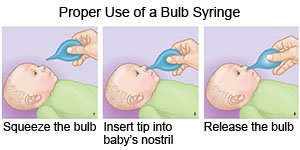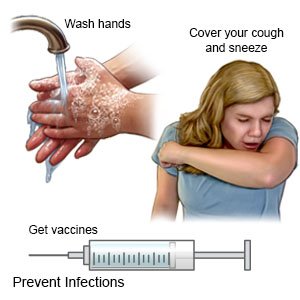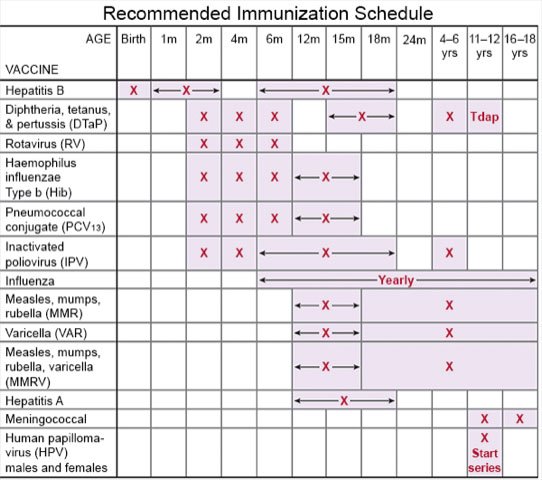Cold Symptoms in Children
Medically reviewed by Drugs.com. Last updated on Apr 6, 2025.
What are the symptoms of a common cold?
A common cold is caused by a viral infection. The infection usually affects your child's upper respiratory system. Your child may have any of the following:
- Chills and a fever that usually last 1 to 3 days
- Sneezing
- A dry or sore throat
- A stuffy nose or chest congestion
- Headache, body aches, or sore muscles
- A dry cough or a cough that brings up mucus
- Feeling tired or weak
- Loss of appetite
How is a common cold treated?
Colds are caused by viruses and will not respond to antibiotics. Medicines are used to help control a cough, lower a fever, or manage other symptoms. Do not give over-the-counter cough or cold medicines to children younger than 4 years. These medicines can cause side effects that may harm your child. Your child may need any of the following:
- Acetaminophen decreases pain and fever. It is available without a doctor's order. Ask how much to give your child and how often to give it. Follow directions. Read the labels of all other medicines your child uses to see if they also contain acetaminophen, or ask your child's doctor or pharmacist. Acetaminophen can cause liver damage if not taken correctly.
- NSAIDs , such as ibuprofen, help decrease swelling, pain, and fever. This medicine is available with or without a doctor's order. NSAIDs can cause stomach bleeding or kidney problems in certain people. If your child takes blood thinner medicine, always ask if NSAIDs are safe for him or her. Always read the medicine label and follow directions. Do not give these medicines to children younger than 6 months without direction from a healthcare provider.
- Do not give aspirin to children younger than 18 years. Your child could develop Reye syndrome if he or she has the flu or a fever and takes aspirin. Reye syndrome can cause life-threatening brain and liver damage. Check your child's medicine labels for aspirin or salicylates.
Treatment options
The following list of medications are related to or used in the treatment of this condition.
- Benadryl
- Vicks NyQuil Cold & Flu Nighttime Relief
- Coricidin HBP Cold & Flu
- Vicks DayQuil Severe Cold & Flu
- Vicks Dayquil Cold & Flu Relief
How can I relieve my child's symptoms?
- Give your child plenty of liquids. Liquids will help thin and loosen mucus so your child can cough it up. Liquids will also keep your child hydrated. Do not give your child liquids that contain caffeine. Caffeine can increase your child's risk for dehydration. Liquids that help prevent dehydration include water, fruit juice, or broth. Ask your child's healthcare provider how much liquid to give your child each day.
- Have your child rest for at least 2 days. Rest will help your child heal.
- Use a cool mist humidifier in your child's room. Cool mist can help thin mucus and make it easier for your child to breathe.
- Clear mucus from your child's nose. Use a bulb syringe to remove mucus from a baby's nose. Squeeze the bulb and put the tip into one of your baby's nostrils. Gently close the other nostril with your finger. Slowly release the bulb to suck up the mucus. Empty the bulb syringe onto a tissue. Repeat the steps if needed. Do the same thing in the other nostril. Make sure your baby's nose is clear before he or she feeds or sleeps. Your child's healthcare provider may recommend you put saline drops into your baby or child's nose if the mucus is very thick.

- Soothe your child's throat. If your child is 8 years or older, have him or her gargle with salt water. Make salt water by adding ¼ teaspoon salt to 1 cup warm water. You can give honey to children older than 1 year. Give ½ teaspoon of honey to children 1 to 5 years. Give 1 teaspoon of honey to children 6 to 11 years. Give 2 teaspoons of honey to children 12 or older.
- Apply petroleum-based jelly around the outside of your child's nostrils. This can decrease irritation from blowing his or her nose.
- Keep your child away from smoke. Do not smoke near your child. Do not let your older child smoke. Nicotine and other chemicals in cigarettes and cigars can make your child's symptoms worse. They can also cause infections such as bronchitis or pneumonia. Ask your child's healthcare provider for information if you or your child currently smoke and need help to quit. E-cigarettes or smokeless tobacco still contain nicotine. Talk to your healthcare provider before you or your child use these products.
How can I help prevent the spread of germs?
 |
- Keep your child away from other people while he or she is sick. This is especially important during the first 3 to 5 days of illness. The virus is most contagious during this time.
- Have your child wash his or her hands often. He or she should wash after using the bathroom and before preparing or eating food. Have your child use soap and water. Show him or her how to rub soapy hands together, lacing the fingers. Wash the front and back of the hands, and in between the fingers. The fingers of one hand can scrub under the fingernails of the other hand. Teach your child to wash for at least 20 seconds. Use a timer, or sing a song that is at least 20 seconds. An example is the happy birthday song 2 times. Have your child rinse with warm, running water for several seconds. Then dry with a clean towel or paper towel. Your older child can use germ-killing gel if soap and water are not available.

- Remind your child to cover a sneeze or cough. Show your child how to use a tissue to cover his or her mouth and nose. Have your child throw the tissue away in a trash can right away. Then your child should wash his or her hands well or use germ-killing gel. Show him or her how to use the bend of the arm if a tissue is not available.
- Tell your child not to share items. Examples include toys, drinks, and food.
- Ask about vaccines your child needs. Vaccines help prevent some infections that cause disease. Have your child get a yearly flu vaccine as soon as recommended, usually in September or October. Your child's healthcare provider can tell you other vaccines your child should get, and when to get them.

When should I seek immediate care?
- Your child's temperature reaches 105°F (40.6°C).
- Your child has trouble breathing or is breathing faster than usual.
- Your child's lips or nails turn blue.
- Your child's nostrils flare when he or she takes a breath.
- The skin above or below your child's ribs is sucked in with each breath.
- Your child's heart is beating much faster than usual.
- You see pinpoint or larger reddish-purple dots on your child's skin.
- Your child stops urinating or urinates less than usual.
- Your baby's soft spot on his or her head is bulging outward or sunken inward.
- Your child has a severe headache or stiff neck.
- Your child has chest or stomach pain.
- Your baby is too weak to eat.
When should I call my child's doctor?
- Your child's oral (mouth), pacifier, ear, forehead, or rectal temperature is higher than 100.4°F (38°C).
- Your child's armpit temperature is higher than 99°F (37.2°C).
- Your child is younger than 2 years and has a fever for more than 24 hours.
- Your child is 2 years or older and has a fever for more than 72 hours.
- Your child has had thick nasal drainage for more than 2 days.
- Your child has ear pain.
- Your child has white spots on his or her tonsils.
- Your child coughs up a lot of thick, yellow, or green mucus.
- Your child is unable to eat, has nausea, or is vomiting.
- Your child has increased tiredness and weakness.
- Your child's symptoms do not improve or get worse within 3 days.
- You have questions or concerns about your child's condition or care.
Care Agreement
You have the right to help plan your child's care. Learn about your child's health condition and how it may be treated. Discuss treatment options with your child's healthcare providers to decide what care you want for your child. The above information is an educational aid only. It is not intended as medical advice for individual conditions or treatments. Talk to your doctor, nurse or pharmacist before following any medical regimen to see if it is safe and effective for you.© Copyright Merative 2025 Information is for End User's use only and may not be sold, redistributed or otherwise used for commercial purposes.
Learn more about Cold Symptoms
- Advil Dosage Charts for Infants and Children
- Benadryl Dosage Charts for Infants and Children
- Can You Drink Alcohol with Antibiotics?
- Claritin Dosage Charts for Infants and Children
- Dosage Charts for Infants and Children
- Motrin Dosage Charts for Infants and Children
- Tylenol Dosage Charts for Infants and Children
- Zyrtec Dosage Charts for Infants and Children
Treatment options
Care guides
Symptoms and treatments
Medicine.com guides (external)
Further information
Always consult your healthcare provider to ensure the information displayed on this page applies to your personal circumstances.
